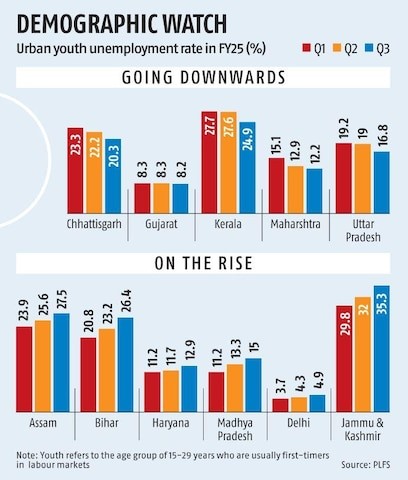|
One Liners 22-02-2025
|
|
History, Art and Culture
|
|
Katas Raj Temple
- Located in – Chakwal in Potohar Plateau, Pakistan.
- Dates back to Hindu shahis King from 615 to 915 AD.
- Composition – It comprises of 7 temples (old and new ones) called the Satgraha.
- Also known for its Buddhist site.
- 300 Indian Hindus travelled to Pakistan to be a part of the celebration.
|
|
Polity & Governance
|
|
98th Akhil Bharatiya Marathi Sahitya Sammelan (All India Marathi Literature Convention)
- It is an annual conference for literary discussions by Marathi writers.
- 1st edition in 1878 & is a long-standing tradition from the late 19th century for Marathi authors and poets to showcase their work.
- The last Sammelan in Delhi took place in 1954, making this event particularly noteworthy.
- Objectives – It celebrate Marathi literature’s timeless relevance, and explore its role in contemporary discourse, including
- Themes of language preservation
- Translation
- Impact of digitalization on literary works.
|
|
Varanasi-Ranchi-Kolkata Expressway Project
- Started on – 2024.
- Umbrella scheme – Bharat Mala Yojana.
- Nodal Ministry – Ministry of Road Transport and Highways.
- It is an approved 710 km long, 6 lane, greenfield access-controlled expressway.
- Objective – To boost trade and freight movement, particularly benefiting industries reliant on the Kolkata and Haldia ports.
- Sates covered – Uttar Pradesh, Bihar, Jharkhand, and West Bengal.
- It is known as Varanasi–Kolkata Expressway (NH-319B).
|
|
Bharat Mala Yojana
- Launched in – 2015.
- It is an umbrella program for the highways sector in India.
- Nodal Ministry – Ministry of Road Transport and Highways.
- Objective – Optimize efficiency of freight and passenger movement across the country.
- Bridge critical infrastructure gaps Enhance
- Coastal and Port Connectivity is Mandatory to connect areas around shorelines and important ports
- It special emphasis on providing connectivity to far-flung border and rural areas.
|
|
Economy
|
|
Periodic Labour Force Survey (PLFS) Terms
- Labour Force Participation Rate (LFPR) – It is defined as the percentage of persons in labour force (i.e. working or seeking or available for work) in the population.
- Worker Population Ratio (WPR) – It is defined as the percentage of employed persons in the population.
- Unemployment Rate (UR) – It is defined as the percentage of persons unemployed among the persons in the labour force.
- Current Weekly Status (CWS) – It determined on the basis of a reference period of last 7 days preceding the date of survey.
|
|
Minor Minerals to Major Minerals
Ministry of Mines moved 4 minerals from minor to major status.
- Major minerals – Barytes, Felspar, Mica, and Quartz
- Quartz - Common mineral in Earth's crust.
- Found in all forms of rock
- Used in clocks and watches
- Feldspar – Aluminosilicate minerals containing calcium, sodium, or potassium.
- Comprises more than half of Earth’s crust.
- Used in glassmaking, ceramics, construction, and manufacturing.
- Mica – Group of minerals that are light, soft, and flexible.
- Used in cosmetics, medicine, and electronics.
- Barytes – Naturally occurring mineral made of barium sulfate (BaSO4).
- Used in paint, rubber, and concrete.
- Quartz, Felspar & Mica - Found in pegmatite rocks
- Important source of many critical minerals.
|
|
Baryte
- Baryte – It is a mineral consisting of barium sulfate and generally white or colorless.
- Occurrence – Vein fillings in limestone and dolostone.
- Iron ore – Pocket type of deposit which can’t be mined in isolation.
- Iron ore of – Antimony, Cobalt, Copper, Lead, Manganese and Silver.
- Usage – Oil and gas drilling, electronics, TV screens, rubber, glass, ceramics, paint, radiation shielding and medical applications.
|
|
Science
|
|
Euclid Space Mission
- Launched in – 2023.
- Developed by – European Space Agency and Euclid Consortium (includes NASA).
- Part of – ESA’s Cosmic Vision programme.
- Purpose – To explore the composition and evolution of the dark universe.
- Euclid Space Telescope – It creates a 3D-map of the universe by observing billions of galaxies out to 10 billion light-years.
|
|
Research Lab for AI in Eye Care
- Established by – Zeiss India (Optics and optoelectronics technology company) and Indian Institute of Science (IISc).
- Established in – IISc, Bengaluru.
- Aim – To drive advancements in eyecare solutions and enable researchers at IISc.
- Objective – To explore the technology’s potential in facilitating early diagnosis, treatment personalization, and accessibility in ophthalmology.
|
|
Index
|
|
Purchasing Managers’ Index (PMI)
- PMI – It is an economic indicator, which is derived after monthly surveys of different companies.
- Released by – Institute for Supply Management (ISM), a non-profit supply management organization on monthly basis.
- Purpose – To provide information about current and future business conditions to company decision makers, analysts, and investors.
- Leading indicator in – United States (US) for determining overall economic activity.
|

